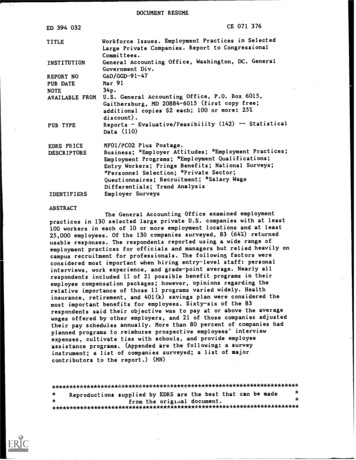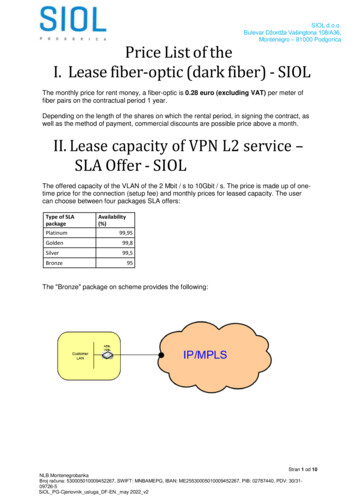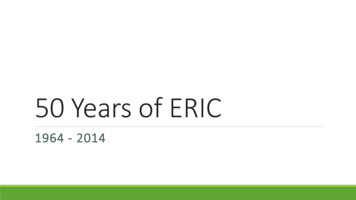
Transcription
DOCUMENT RESUMECE 071 376ED 394 032TITLEINSTITUTIONREPORT NOPUB DATENOTEAVAILABLE FROMPUB TYPEEDRS PRICEDESCRIPTORSIDENTIFIERSWorkforce Issues. Employment Practices in SelectedLarge Private Companies. Report to CongressionalCommittees.General Accounting Office, Washington, DC. GeneralGovernment Div.GAO/GGD-91-47Mar 9134p.U.S. General Accounting Office, P.O. Box 6015,Gaithersburg, MD 20884-6015 (first copy free;additional copies 2 each; 100 or more: 25%discount).StatisticalEvaluative/Feasibility (142)ReportsData (110)MF01/PCO2 Plus Postage.Business; *Employer Attitudes; *Employment Practices;Employment Programs; *Employment Qualifications;Entry Workers; Fringe Benefits; National Surveys;*Personnel Selection; *Private Sector;Questionnaires; Recruitment; *Salary WageDifferentials; Trend AnalysisEmployer SurveysABSTRACTThe General Accounting Office examined employmentpractices in 130 selected large private U.S. companies with at least100 workers in each of 10 or more employment locations and at least25,000 employees. Of the 130 companies surveyed, 83 (64%) returnedusable responses. The respondents reported using a wide range ofemployment practices for officials and managers but relied heavily oncampus recruitment for professionals. The following factors wereconsidered most important when hiring entry-level staff: personalinterviews, work experience, and grade-point average. Nearly allrespondents included 11 of 21 possible benefit programs in theiremployee compensation packages; however, opinions regarding therelative importance of those 11 programs varied widely. Healthinsurance, retirement, and 401(k) savings plan were considered themost important benefits for employees. Sixty-six of the 83respondents said their objective was to pay at or above the averagewages offered by other employers, and 21 of those companies adjustedtheir pay schedules annually. More than 80 percent of companies hadplanned programs to reimburse prospective employees' interviewexpenses, cultivate ties with schools, and provide employeeassistance programs. (Appended are the following: a surveyinstrument; a list of companies surveyed; a list of majorcontributors to the report.) *************************Reproductions supplied by EDRS are the best that can be madefrom the original **********************k*******
Vntied.States Gvaeral Acc.,(.)afititig Qffie.BEST COPY AVAILABLE
GAOUnited StatesGeneral Accounting OfficeWashington, D.C. 20548General Government DivisionB-242808March 13, 1991The Honorable John GlennChairman, Committee onGovernmental AffairsUnited States SenateThe Honorable William L. ClayChairman, Committee onPost Office and Civil ServiceHouse of RepresentativesWe are undertaking a series of examinations to assess the government'spreparedness to attract and retain needed employees now and in thefuture. As part of this work, we will identify employment practices inthe nonfederal sector that may have application in the government.This report presents data we have developed to date on nonfederalemployment practices that we believe will be of interest to you. Weobtained the data from a questionnaire survey of large companies withnumerous employment locations throughout the country. The questionnaire asked about recruiting and hiring practices, benefit programs, paypractices, and other programs in place or planned to deal with issuessuch as family concerns, alternatives to traditional work arrangements,older workers, and managing the increasingly diverse workforce.We will issue further reports as we obtain more in flepth information onapproaches nonfederal employers are using to enhance their ability tomaintain a quality workforce.ApproachWe limited the survey to private companies that, like the government,had employees in multiple locations. We mailed questionnaires to all U.S.companies that our data source showed had at least 25,000 employeesand 10 or more employment locations., (See app. I for a copy of thequestionnaire.) The data source identified 153 such companies. We thenfurther limited our analysis to companies that in addition to the abovecriteria, also had at least 100 workers in each of the 10 or more locations. On the basis of information subsequently provided in the companies' completed questionnaires or in telephone conversations with'Our data source was the August 1989 file compiled by Trinet, Inc., a provider of information onAmerican businesses. This file has information on public and private U.S. companies in all sectors ofindustry that have 20 or more employees.Page 1GAO/GGL19147 Employment Practices in Large Companies
B-242808company representatives, we excluded 23 of the 153 companies becausethey were below our size cut-off or did not have at least 100 workers ineach of 10 or more locations. Of the final universe of 130 companies, wereceived 83 usable responses for a response rate of 64 percent. (See app.II for a listing of the 130 companies.) The information in this report onlypertains to the 83 respondents and cannot be used to generalize aboutemployment practices in the private sector as a whole.According to demographic projections, an increasing number of jobs willrequire college degrees in the 1990s and beyond; yet, the number ofpeople with the qualifications to fill these positions is expected todecline., Therefore, the questionnaire asked about the methods the companies used to attract new employees for jobs in the officials and managers category and in the professionals category.,The respondents reported they used a relatively wide range of recruitment practices for officials and managers but relied heavily on campusrecruitment for professionals.For officials and managers, 23 respondents said they used campusrecruitment to a great or very great extent. However, 40 respondentssaid they used college recruitment to little or no extent for officials andmanagers. In fact, none of the recruiting methods listed in the questionnaire dominated in the companies' responses for this job category.Referrals from company employees, external search firms, and newspaper advertisements received the most ratings between some and greatextent, but none of these methods was rated highly by a majority of therespondents. Job fairs were the least used method to recruit officialsand managers. Table 1 shows the recruitment methods used by therespondents to recruit officials and managers.2, for example, Workforce 2000, Hudson Institute (June 1987) and Civil Service 2000, HudsonInstitute (June 1988).30fficials and managers are personnel who set broad policies, exercise overall responsibility for execution of these policies, and direct individual departments or special phases of a firm's operations(e.g., executives, plant managers, and superintendents). Professional occupations require a collegedegree or comparable background (e.g., accountants, architects, and engineers).Page 24A0/GG13-91-47 Employment Practices in Large Companlea
B442808Table 1: Use of Various RecruitmentMethods for Officials and ManagersExtent usedLittle orVerygreatMethodsGreatModerateSomeno(Number of respondents)31497940External search firms824221611Referrals from company employees613222910Newspaper ads515271618Company brochuresEmployment agencies5713124239221629Job fairs34121150Trade journals and magazines18172826Campus recruitingaThe number of companies in each row does not total 83 because some companies did not answer for aparticular recruitment method.As shown in table 2, campus recruitment was the dominant recruitingmethod for professional positions. Fifty-two companies said they usedcollege- recruiting to a great or very great extent. Newspaper advertisements was the second highest rated method, with 36 respondentsreporting it was used to a great or very great extent. Other, less utilizedrecruitment methods for professionals included referrals from companyemployees, company brochures, trade journals, job fairs, search firms,and employment agencies.Table 2: Use of Various RecruitmentMethods for ProfessionalsExtent usedLittle orVeryMethodsgreatGreatModerateSomeno(Number of respondents)aCampus recruitingNewspaper adsReferrals from company employees30221310611252413862022276Company brochures714212018Trade journals and magazines316203210Job fairsExternal search firms711242217310232717Employment agencies57291525aThe number of companies in each row does not total 83 because some companies did not answer for aparticular recruitment method.Most respondents said they began their reeruitment efforts for positionsthat require college degrees when students were still in schoolnotafter they graduated. For example, 38 companies targeted collegePage 31.)GAO/GGD-91-47 Employment Practices in Urge Companies
juniors, and 24 targeted students in their freshman or sophomore yearsof college.4 In addition, 16 of the companies said that they targeted students in their senior year of high school or upon graduation from highschool. Of the 83 companies, 12 companies said they did not target students before graduation for positions that require college degrees.Under the presumption that employers receive more applications fromcollege graduates for available positions than the number actually hired,the questionnaire asked about the factors the companies used indeciding which applicants to hire. The factor receiving the highestrating was the personal interview. (See table 3.) Forty-six companiesrated the personal interview as being of very great importance, and 33rated it as being of great importance. Other factors that at least half therespondents considered to be of great or very great importance weregrade point average and work experience. Very few respondents saidthey considered tests of any kind (aptitude, psychological, or honesty)to be important factors in deciding whom to hire. Of the companies whosaid they used such tests, the responses tended to be clustered aroundmoderate to little or no importance.Table 3: Importance of Various FactorsConsidered by Companies When HiringEntry Level StaffLevel of ImportanceVeryLittleor noDid notuse0006101630033281020731211362Extracurricular activities122371630Worked to pay owncollege expensesFactorsgreatGreatPersonal interviews46332Work experience183223Grade point averageCollege attendedReferences13487ModerateSome(Number of respondents)a314302381Community involvementAptitude tests0133329305416614Psychological testsHonesty tests325292143933.5759'The number of companies in each row does not total 83 because some companies did not answer for aparticular factor.4For this question, companies could check as many boxes as applied so the numbers of responsesexceeded 83.Page 46GAO/GG1)-8147 Employment Practices in Large Companies
Benefit PracticesThe questionnaire listed 21 benefit programs and asked the respondentsto rate the importance of each benefit as part of an employee compensation package. The respondents were asked to rate the benefits separately for exempt and nonexempt employees.5 The respondents' views ofthe importance of specific benefit programs were generally comparablefor exempt and nonexempt employees, indicating that the companies didnot perceive any significant differences in the benefit program needs ofthese different employee types.Nearly all of the respondents included 11 of the 21 benefit programs intheir employee compensation packages.6 However, the companies' 'ratingof the importance of the 11 programs varied considerably. Over 85 percent of the respondents (71 to 78 companies) rated each of three benefitprograms as being of great or very great importance. These programswere health insurance (rated the most important of all the 21 programs),retirement plan, and employee savings plan. Forty to 77 percent of therespondents (33 to 63 companies) rated each of the other eight benefitprograms as being of great or very great importance. These programswere life insurance, dental insurance, long-term disability insurance,vacation days, short-term disability insurance, survivor benefits in theretirement plan, disability retirement plan, and paid holidays.The remaining 10 benefit programs often were not provided in therespondents' compensation packages (from 18 to 68 of the 83 companiesdid not provide them), and most of the companies that provided thesebenefits considered them to be of little to moderate importance. These10 benefits were employee stock ownership plan, employee stockpurchase plan, sick days, profit sharing plan, personal days off, visioncare, income tax advantages to employees, discounted or free companyproducts and services, discounted or free parking, and legal services.Table 4 shows how the respondents rated the importance of the 21 benefits for exempt employees."In general, nonmanagement positions (blue-collar, clerical, technical, etc.) are classified as nonexempt, meaning they are subject to the overtime provisions of the Fair Labor Standards Act. Otheremployees are usually considered exempt from the provisions of the act."The data presented here are for exempt employees because the federal government employed moreexempt than nonexempt employees as of September 1990.GAO/GGD81-47 Employment Practices in Large CompaniesPage 57
Table 4: Importance of Various Benefits for Exempt EmployeesLevel of importanceVeryBenefitsgreatGreatModerateSomeLittle ornoBenefitnotoffered(Number of respondents)aHealth insurance58204100Retirement49245203401(k) savings plan47246600Life insurance243916300Dental insurance232925204Long term disability insuranceVacation daysShort term disability insuranceSurvivor ility retirementPaid holidays142325103762737921Employee stock ownership planStock purchaseIncome tax advantageProfit sharing13161035341114131028819249111056434Sick days3162410723Personal days3162410620Vision care4111512437Product 4aThe number of companies in each row does not total 83 because some companies did not answer for aparticular benefit.The questionnaire also asked about the companies' practices regarding"cafeteria benefit" plans. These types of plans allow employees to tailorbenefit packages to meet their own needs within specified cost limits. Ofthe 82 companies responding to this question, 9 said they had cafeteriaplans in place. A number of respondents-20 companiessaid theyoffered employees some choices in benefits but not a full cafeteria benefit plan. Five others said they had decided to offer cafeteria benefitplans in the future, and 19 respondents said they were considering cafeteria benefit plans but had not yet made final decisions. Nineteenrespondents said they had considered cafeteria benefit plans butdecided not to implement them.Page 6GAO/GGD-9147 Employment Practices In Large Companies
Private Sector PayPracticesThe need to pay competitive wages and salaries was clearly an important objective for the survey respondents. Sixty-six of the 83 companiessaid their objective was to pay at or above the average of what otheremployers pay. lf these 66 companies, 21 said their objective was topay above the average. Also, 67 companies said they adjust their payschedules annually.When asked specifically about other employers whom the respondentsconsidered to be their competition for wage and salary rates, 76 of the83 companies said it was of great importance to pay rates comparable toother employers in their own industries. Ten companies said it was ofgreat importance to consider all industries in determining wage andsalary amounts. Moreover, the respondents generally considered companies of similar size to be their wage and salary competitors. While 52companies said it was of great importance to pay rates comparable toother companies of similar size, 8 companies felt it was of great importance to consider companies of all sizes.The respondents also indicated that cost-of-living considerations areoften an important factor when they adjust their wage and salary schedules. Sixty-three companies said they consider the cost of living; 39 ofthese 63 companies said cost of living was of moderate to great importance in their adjustment prorPqqes. Nineteen companies said they didnot consider the cost of living when adjusting their wage and salaryschedules.A widely followed practice among the respondents was to base individual employees' pay adjustments on job performance. Seventy-eightcompanies said the individual's job performance was of great importance when determining the amount of pay. In fact, 45 companies saidthey did not grant increases to all employees when wage and salaryschedules were adjusted, and 60 companies either did not considerlength of service in the job in granting individual pay increases or considered it to be of little importance.Thirty-seven companies said they considered group performance indetermining pay increases; however, only one company consideredgroup performance to be of great importance compared to individualperformance.Locality Pay PracticesWe asked the companies about the extent to which their wage andsalary schedules for the san, a jobs differed by geographic location. ThePage 7GAO/GM:4147 Employment Practices In Large Companies9
companies were asked to specify their locality pay practices for nine jobcategories, including officials and managers, professionals, technicians,sales people, office and clerical workers, craft workers (skilled), operatives (semiskilled), laborers (unskilled), and service employees.7 While awide variety of practices was reported, 71 of the 83 companies (about85 percent) said their wage or salary schedules differed by locality forat least one of the job categories.Twelve companies said they used national schedules for all employeecategories, and one company used local schedules for all categories. Theremaining 70 companies reported a combination of national and localschedules. In these 70 companies, 40 used national schedules for all officials and managers and professional staff; an additional 10 usednational schedules for all their officials and managers. In 2 of the 70companies, national schedules were used for professional staff only.Even when national schedules were used for specific employee categories, over half the respondents said they provided these categories sometype of differential based on geographic location. Assistance withhousing costs in particular locations was the differential type most oftenreported, but the companies cited other locality differentials such asadding cost-of-living allowances to salary rates, providing incentive-tomove payments, adding onto base pay, varying pay raises, and placingemployees in different levels of the pay range. Forty-five companiesreported such differential practices.In determining local pay schedules, some respondents said they considered rates paid by other employers in the locality. About the samenumber said they considered both local prevailing pay rates and localcost of living. A small number said they considered only cost-of-livingdifferences among localities. Table 5 shows the factors, by job category,the respondents said they considered in determining local schedules.7The service category includes attendants, such as nurse's aides and orderlies, elevator operators,janitors, doorkeepers, guards, and cleaners.1. 0Page 8GAO/GGD-9147 Employment Practices in Large Companies
B-242908Table 5: Factors Used by Companies inEstablishing Local Wage and SalarySchedules,'Cost ofliving onlyJob categoriesRates paid by otheremployers in thelocality onlyCombinationof the twofactors Otherb(Number of 7Sales peopleOffice and clericalworkers214145134288Craft workers (skilled)1272612Operatives (semiskilled)Laborers (unskilled)Service employees12925111292591282610Officials and managersalData in this table are limited to responses by the 71 companies that inCicated they used local schedules for at least one of the job categories.bCollective bargaining with employee unions was the "other" factor most often mentioned by companies that checked this category.Other EmploymentPracticesThe questionnaire asked the companies about other programs theymight be plannir.g or have in place to assist in attracting and retainingPmployePQ. Ninetaen such programs were listed in the questionnairPapp. I, section IV). Most of these programs focused on family issues andother employment challenges presented by demographic changes in thenation's workforce.Five programs stood out as well established among the survey companies; more than 80 percent of the respondents (67 to 78 companies) indicated that programs were in place or planned to (1) reimburse interviewexpenses of prospective employees, (2) cultivate ties with schools tohelp improve the quality of potential future employees, (3) provideemployee assistance programs, (4) sponsor health and wellness programs, and (5) allow employees to take unpaid parental or family leave.8(See fig. 1.)8Employee assistance programs provide counseling and referral services to help employees with personal and family problems.GAO/GGD-9147 Employment Practices in Large CompaniesPage 911
B-242808Figure 1: Employment Programs Widelyin Place or Planned by the RespondentsNumber ot respondents o70soso403020101741Aa-iiitEmployment progmmsI/in place or plannedConsideringDon't have; not plannedNote: The number of companies does not total 83 because some companies did not answer for a particular employment program.-- \Between 50 and 80 percent of the respondents (41 to 64 companies) saidfive other programs were in place or planned. These programs included(1) retraining for current employees when necessary, (2) assistingspouses of transferring employees to find jobs in the new location, (3)alternative work schedules, (4) encouraging retirees to return to workwhen temporary needs arise, and (5) providing remedial training fornew employees when necessary. (See fig. 2.)12Page 10GAO/GGD-9147 Employment Practices in Large Companies
Figure 2: Employment Progra ns in Placeor Planned by the Majority ofRespondentsNumber of respondents O70so10Employment programsin plat* or plannedConsideringDont ham not plannedNote: The number of companies does not total 83 because some companies did not answer for a particular employment program.Five programs were in place or planned by fewer than half of therespondents (23 to 38 companies), but, if adopted by all other respondents that said they were considering the programs, would be in placefor the majority. Programs in this category included (1) child care assistance, (2) encouraging continued employment of retirement-ageemployees, (3) assistance in caring for elderly parents and other familymembers, (4) job sharing, and (5) alternate work arrangements (e.g.,work at home). (See fig. 3.)Page I l13GAO/GED.91-47 Employment Practices in Large Companies
Figure 3: Employment Programs in Placeor Planned by Fewer Than Half ofRespondents but Being Considered by aNumber of Others60Number at respondents7060SO40302010044"EmPeekinsfit Programki place or plumedConekerdmDon't haw not plannedNote: The number of companies does not total 83 because some companies did not answer for a particular employment program.The remaining four programs were in place or planned by very fewrespondents (2 to 17 companies). These programs included (1) paidparental or family leave, (2) payment of prospective employees' collegeexpenses, (3) payment of "last move home" expenses for retiringemployees who had transferred during their careers, and (4) help inrepaying new employees' educational loans. (See fig. 4.)14Page 12GAO/GGD-91-47 Employment Practices in Large Companies
B-242808Figure 4: Employment Programs in Placeor Planned by Very Few RespondentsSONumber of mapoodenta70soso3020'10Employment programaIn place or plannedConsideringDon't have; not plannedNote: The number of companies does not total 83 because some companies did not answer for a particular employment program.Copies of this report are being sent to parties interested in federalemployment matters and will be available to others upon request.The mWor contributors to the report are listed in appendix III. Pleasecall me on (202) 275-6204 if you have any questions.cr-9Rosslyn S. KleemanDirector, Federal Workforce Future IssuesPage 1315GAO/GGD4147 Employment Practices in Large Companies
ContentsLetter1Appendix ISurvey of Pay andEmployment Practicesin the Private Sector16Appendix IIList of the 130Companies in OurSurvey29Appendix IIIMajor Contributors toThis ReportTablesFigures31Table 1: Use of Various Recruitment Methods for Officialsand ManagersTable 2: Use of Various Recruitment Methods forProfessionalsTable 3: Importance of Various Factors Considered byCompanies When Hiring Entry Level StaffTable 4: Importance of Various Benefits for ExemptEmployeesTable 5: Factors Used by Companies in Establishing LocalWage and Salary SchedulesFigure 1: Employment Programs Widely in Place orPlanned by the RespondentsFigure 2: Employment Programs in Place or Planned bythe Majority of RespondentsFigure 3: Employment Programs in Place or Planned byFewer Than Half of Respondents but BeingConsidered by a Number of OthersFigure 4: Employment Programs in Place or Planned byVery Few Respondents334691011121316Page 14GAO/GGD6147 Eniployment Praetkes In Lsrge Companies
Appendix ISurvey of Pay and Employment Practices in thePrivate SectorU.S. General Accounting OfficeSurvey of Pay and EmploymentPractices in the Private Sector!strained.*Please provide the foaming information:The U.S. General Accounting Office is seeking information on privatesector pay and other employment practices and their possible applicability to the federal government. The survey is being sent to 14 large companies with employees in at least 10 locations In the United States.Company name.Respondent name.Respondent title.Most of the questions can he easily answered by checking boxes. Specehas been provided for any additional commeras at the end of the questionnaire. If necessary, additional pages may be attached.Telephone wsmber(Ana code)(NtwataoThe questionnaire should take about 30 minutes to complete. If you haveady questions, please call Bob Shelton n (202) 275-6038 or CurtisCopeland at (202) 275-8101.Your responses will be treated confidendally and will not be used inany way that will identify your company or its practices. Please teturnthe completed questionnaire in the pre-addressed envelope within 10daysof receipt. In the event the envelope Is misplaced, the return address is:A. Please enter below the approximate number of permanent employeesIn your company in 1919. (ROUND TO ME NEAREST 1,000)U.S. General AcconMIng OlfleeMr. Curtis CopelandRoom 3121441 G Street, N.W.Washington, D.C. 20541a. Number of MI-time employeesb. Number of part-drne ernployeesThe questionnaire results and other analyses we are doing will be included in our report to Congress. We will be pleased to provide copiesof the report to all survey participants.Thank you for your help.IF YOU ARE A PARENT COMPANY WITH ONE OR MORESUBSIDIARIES, PLEASE RESPOND TO THIS QUESTIONNAIRE FOR THE PARINT COMPANY ONLY.c. TOTALB. Please enter below the number of states and cities/counties in whichyou have establishments of at least 100 empioyees each.a. Number of statesb. Number of cities/countiesIF YOU DID NOT ENTER AT LEAST "10" IN EITHER B.aOR B.b ABOVE, PLEASE STOP HERE AND RETURN THEQUESTIONNAIRE.BEST COPY AVAIIABLE17Page 16GAO/GGD-9147 Employment Practices in Large Companies
Appendix ISurvey of Pay and Employment Practices inthe Private SectorI.PAY PRACTICESI. In your company, of how much importance are the following cemperdation approaches in setting employee pay levels? (CHECK ONE BOXIN EACH ROW. IF A LISTED APPROACH IS NOT FOLLOWED, CHECK COLUMN I.)Notapplicable(I)PAY SETTING ce importance(4)(3)awmaga.,:mwmp.,.4.:::::., a,zsIm, ,:::ivippenvinrn:0:;.:4-g.:::i:,.,x.:'I. Wages and salaries are comparable with rates Fuld by other employers(either locally or nationally):'iDAM::::'.a. In all industriesb. In our industryC. Of all sizesd. Of comparable size tO OUr company2. Wage and salary schedule adjustments reflect changes in the coatof living3. Increases are granted to all employees when wage and salary schedulesare adjusted4. Employees move through the wage and salary schedules bmed onindividual performance5. Employees move through the wage and salary schedules bred Oa /eolithof service in the job,6. lab performance ls assessed and reward& are determined on a group basis,rather than an individual employee basis7. Other (specify)3. How often are your company's wage and salary schedules adjusted?2. What is your company's wage and salary objective In relation tomarket rates? (CHECK ONE.)(CHECK ONE.)I. 0 Generally above the 50th percentile of others' ratesI. 0 More often than annually2. 0 About the 50th percentile of others' rates2. 0 Annually1. 0 Generally below the 50th percentile of others' rates3. El Less often than annually4. 0 Other (specify)4. 0 Other (specify)5. 0 Not applicable/not an objective2Page 1718GAO/GGD-91-47 Employment Practices In Large Companies
Appendix ISurvey of Pay and Employment Practices inthe Private SectorLOCAL WAGE OE SALARY SCHEDULES4. Do your company's wage or salary schedules differ by geographic location for any employees, ill any job category, le., are the same jokepaid more or less in some locations dna I. others7 (CHECK ONE.)I. 0 Yes (CONTINUE TO QUESTION 5.)2. 0 No (SKIP TO NOTE ABOVE QUESTION 11.)5. For each job category, please indicate if a local, national, or a combination type of wage or salary schedules applies. (CHECK ONE BOXFOR EACH CATEGORY. IF YOU DON'T HAVE EMPLOYEES IN A JOB CATEGORY, CHECK COLUMN I. NOTE: THESE JOBCATEGORIES ARE THE SAME AS ON THE EMPLOYER
received 83 usable responses for a response rate of 64 percent. (See app. . were life insurance, dental insurance, long-term disability insurance, vacation days, short-term disability insurance, survivor benefits in the retirement plan, disability retirement plan, and paid holidays.









